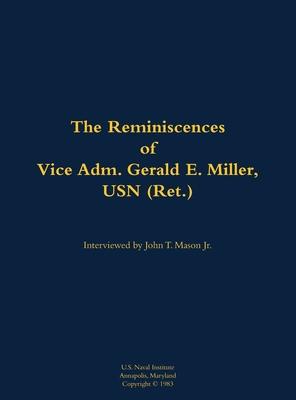In order to get into naval aviation, Admiral Miller took a long route. He enlisted in the Navy in 1936 and served in the fleet for two years before getting an appointment to the Naval Academy, from which he was graduated in late 1941. He then spent two years of wartime duty in the light cruiser USS Richmond (CL-9) before he could go to flight training. He didn’t get an opportunity for wartime air combat. After the war, he went to postgraduate school at Stanford University and continued his flying career. Throughout his aviation experiences, he placed particular emphasis on night-time flight operations. During the Korean War, he served on the staff of Rear Admiral E. C. Ewen, Commander Task Force 77, and then commanded a fighter squadron. During a mid-1950s tour in the Bureau of Naval Personnel, Miller was instrumental in the installation of computers and reorganizing the distribution of enlisted personnel. After commanding a carrier air group, he was sent to Omaha, Nebraska, to work with the Air Force in joint strategic target planning. In the early 1960s, he commanded the ammunition ship USS Wrangell (AE-12) and the attack aircraft carrier Franklin D. Roosevelt (CVA-42). In discussing the latter, he stresses Mediterranean operations and the role of the commanding officer as leader. The concluding volume picks up his story when he was serving as aide to the Vice Chief of Naval Operations, Admiral Horacio Rivero, during which time he indoctrinated the admiral in naval aviation. In his next duty, as Director, Aviation Plans Division in OpNav, Miller played a role in the knockdown of the controversial F-111B program. He also pushed for the purchase of RA-5 reconnaissance aircraft, a decision he subsequently came to regret. He concedes he was given little role in the Vietnam War but did participate in a satisfying electronic silence naval exercise off Korea. Following duty as Assistant DCNO (Air), he became Commander Second Fleet and observed what he felt were the negative effects of Z-grams. Miller considers his Second Fleet duty to have been perfect preparation for his subsequent tour as Commander Sixth Fleet. Facets covered from this service were dealings with the Soviet ships in the Mediterranean, racial tensions, and the deterioration of discipline and appearance among the fleet’s sailors. Miller sought to reverse the trend resulting from Z-grams and says he considered the possibility Admiral Zumwalt would fire him for his efforts. In his final tour, Admiral Miller was Deputy Director of the Joint Strategic Target Planning Staff in Omaha, and he made it a project to familiarize U.S. civilian and military leaders with operational plans for nuclear war. Throughout his narrative, Miller’s strong leadership style is evident, and he offers opinions on the application and failure of leadership skills.
| FindBook |
有 1 項符合
Reminiscences of Vice Adm. Gerald E. Miller, USN (Ret.)的圖書 |
 |
Reminiscences of Vice Adm. Gerald E. Miller, USN (Ret.) 作者:Miller 出版社:US Naval Institute Press 出版日期:2008-01-15 語言:英文 規格:精裝 / 840頁 / 27.94 x 21.59 x 4.45 cm / 普通級/ 初版 |
| 圖書館借閱 |
| 國家圖書館 | 全國圖書書目資訊網 | 國立公共資訊圖書館 | 電子書服務平台 | MetaCat 跨館整合查詢 |
| 臺北市立圖書館 | 新北市立圖書館 | 基隆市公共圖書館 | 桃園市立圖書館 | 新竹縣公共圖書館 |
| 苗栗縣立圖書館 | 臺中市立圖書館 | 彰化縣公共圖書館 | 南投縣文化局 | 雲林縣公共圖書館 |
| 嘉義縣圖書館 | 臺南市立圖書館 | 高雄市立圖書館 | 屏東縣公共圖書館 | 宜蘭縣公共圖書館 |
| 花蓮縣文化局 | 臺東縣文化處 |
|
|
圖書介紹 - 資料來源:博客來 評分:
圖書名稱:Reminiscences of Vice Adm. Gerald E. Miller, USN (Ret.)
|





![塔木德:猶太人的致富聖經[修訂版]:1000多年來帶領猶太人快速累積財富的神祕經典 塔木德:猶太人的致富聖經[修訂版]:1000多年來帶領猶太人快速累積財富的神祕經典](https://media.taaze.tw/showLargeImage.html?sc=11100697818)





